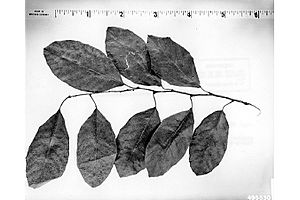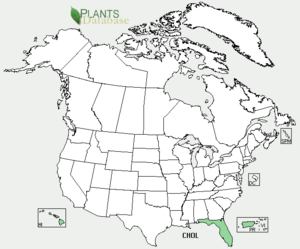Satinleaf facts for kids
Quick facts for kids Satinleaf |
|
|---|---|
 |
|
| Satinleaf leaves and fruits in Florida | |
| Scientific classification | |
| Genus: |
Chrysophyllum
|
| Species: |
oliviforme
|
| Synonyms | |
|
Chrysophyllum microphyllum Jacq. |
|
The satinleaf tree, officially known as Chrysophyllum oliviforme, is a beautiful medium-sized tree. It grows naturally in places like Florida, the Bahamas, the Greater Antilles, and Belize. People also call it by other names, such as Damson plum or wild star-apple.
This tree gets its name "satinleaf" because of its unique leaves. The top side of each leaf is a shiny dark green, while the bottom side is a pretty light brown or copper color. This special look makes the satinleaf a popular tree for decorating yards and public areas.
Contents
About the Satinleaf Tree
The satinleaf tree was first described by a famous scientist named Carl Linnaeus in 1759. He was the one who gave it its scientific name. Scientists have studied its DNA and how it looks to understand its family tree. They found that the satinleaf is closely related to another tree called C. cainito.
What the Satinleaf Looks Like
Satinleaf trees are usually small, growing about 3 to 5 meters (10 to 16 feet) tall. But in good conditions, they can reach up to 10 meters (33 feet) high! Their trunks can be about 30 centimeters (12 inches) wide. The bark is thin and gray-brown, with small cracks. Most satinleaf trees have only one main trunk. As the tree gets older, its branches tend to droop a little.
The leaves are what make this tree special. They grow alternately along the branches and are a shiny dark green on top. The bottom of the leaves is a lovely light brown. They are shaped like an oval and stay on the tree all year round. Each leaf can be from 3 to 11 centimeters (1 to 4 inches) long and 2 to 5 centimeters (0.8 to 2 inches) wide.
Flowers and Fruits
Satinleaf trees can flower all year in some places, like Florida. In other areas, such as Puerto Rico, they flower from July to October. The flowers are small, usually about 3 to 5 centimeters (1 to 2 inches) across, and are a creamy yellow color. Insects help pollinate these flowers.
The fruits take several months to grow and are usually ready to eat by February. When they are young, they are green, but they turn a dark purple color when ripe. The fruits are about the size of an olive. Inside, they have a white, soft flesh that covers several black seeds. The seeds are protected by a rubbery skin. If you cut a fruit, you might see a milky white liquid come out from the seeds. Birds love to eat these fruits, and they help spread the seeds when they fly. These trees grow slowly over time.
Where the Satinleaf Grows
The satinleaf tree is native to warm, tropical places like Florida, the Bahamas, the Greater Antilles, and Belize. People also plant it as a decorative tree in many other tropical countries.
However, in Hawaii, the satinleaf has become an invasive species. This means it grows too well there and can harm the local plants. In Florida, the satinleaf is listed as an endangered species in the wild. Even though it's endangered in nature, you can still find many of them in south Florida because people plant them for their beauty.
Where the Satinleaf Lives
Satinleaf trees are quite adaptable. They can grow in many different types of soil, including clay, sand, or loam. They don't mind if the soil is alkaline or acidic, or if it's well-drained or a bit moist. In Puerto Rico, they grow in sand and shallow clay. In Florida, you can find them in pine forests and hammocks (small islands of trees). They grow well in moist forests that are not too high up.
These trees can handle a little bit of salt and can survive moderate dry periods. They can also grow in soil with a pH between 5 and 8. But they really don't like cold weather. Temperatures below 0°C (32°F) can seriously damage them.
Uses of the Satinleaf Tree
Food
The fruits of the satinleaf tree are edible. People usually eat them fresh. They are a bit chewy, but they are safe to eat.
Other Uses
The wood from the satinleaf tree is hard, heavy, and strong. Because of this, it is used in construction. It can be difficult to carve, but it's great for things that need to be very strong, like fence posts or beams.
As mentioned before, the satinleaf is also a popular tree for decoration. People plant it in their yards, along sidewalks, and in other public areas because of its beautiful leaves and overall look.
See also
 In Spanish: Chrysophyllum oliviforme para niños
In Spanish: Chrysophyllum oliviforme para niños



